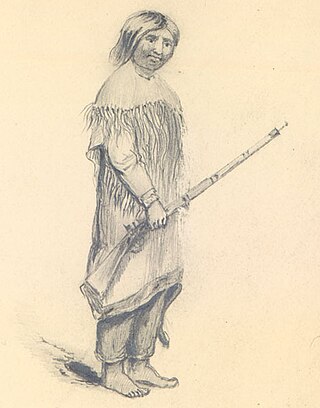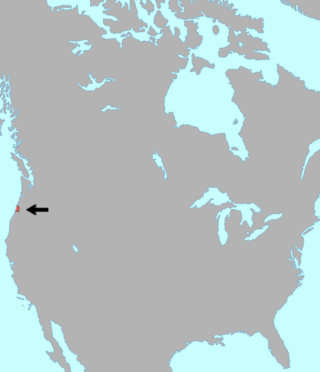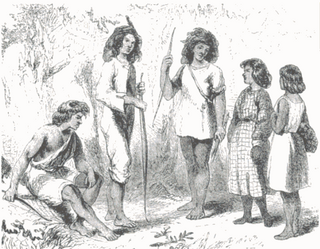Phonology
As with many Athabaskan languages, Tolowa features contrasting aspirated, unaspirated, and ejective stops, as well as contrasting vowel length and nasality. Tolowa is not fully tonal, but instead has a pitch accent. [4] This is typical of the Pacific Coast Athabaskan languages.
Consonants
/ɬ/ is affricated to [ tɬ ] after vowels. /j/ is realized as [ j̃ ] after nasal vowels. [4]
Vowels
Tolowa vowels have some degree of allophonicity. /u/ and /o/ are in free variation; [ ɔ ] is an allophone of /a/ after palatals and velars; /ə/ is raised to [ ɨ ] near palatals and to [ ʉ ] before velars, and is nasalized ([ə̃]) before nasal consonants. [4] In addition, Tolowa has three diphthongs: [ai], [au], and [ui]. [5]
Alphabet
Syllables are usually separated with an en dash (-) for clarity. The 1997 Tolowa Dee-niʼ alphabet (below) replaces the special characters ą, į, ɨ, ł, ų, and ʉ with a~, i~, lh, u~ and v, respectively. Note that the distinction between ɨ and ʉ is lost.
Tolowa Dee-niʼ alphabet [5] | Spelling | a | aa | a~ | aa~ | b | ch | chʼ | d | dr | e | ee | g | gh | gw | h | i | ii | i~ | ii~ | kʼ | krʼ | l | lh | m | n | p | s | sh | sr | t | t’ | trʼ | tsʼ | u | uu | u~ | uu~ | v | w | x | xw | y | ʼ |
|---|
| Phoneme | a | aː | ã | ãː | p | tʃʰ | tʃʼ | t | tʃ | e | eː | k | ɣ | kʷ | h | i | iː | ĩ | ĩː | kʼ | kʷʼ | l | ɬ | m | n | pʰ | s | ʃ | ʂ | tʰ | t’ | ʈʂʼ | tsʼ | u | uː | ũ | ũː | ə | w | x | xʷ | j | ʔ |
|---|
The Coquille are a Native American people who historically lived in the Coquille River watershed and nearby coast south of Coos Bay. They were signatories of the Oregon Coast Tribes Treaty of 1855 and were subsequently removed to the Siletz Reservation in northwestern Oregon in 1856. Most Coquille people today live there as members of the Confederated Tribes of Siletz Indians, but some whose ancestors remained in the traditional homeland or fled the reservation now make up the Coquille Indian Tribe, centered in southwest Oregon where the Coos River flows into Coos Bay.

The Umpqua people are an umbrella group of several distinct tribal entities of Native Americans of the Umpqua Basin in present-day south central Oregon in the United States. The area south of Roseburg is now known as the Umpqua Valley.

Athabaskan is a large family of Indigenous languages of North America, located in western North America in three areal language groups: Northern, Pacific Coast and Southern. Kari and Potter (2010:10) place the total territory of the 53 Athabaskan languages at 4,022,000 square kilometres (1,553,000 sq mi).
The Tututni tribe is a historic Native American tribe, one of Lower Rogue River Athabascan tribes from southwestern Oregon who signed the 1855 Coast Treaty, and were removed to the Siletz Indian Reservation in Oregon. They traditionally lived along the Rogue River and its tributaries, near the Pacific Coast between the Coquille River on the north and Chetco River in the south. Lower Rogue River Athabascan tribes are a group of Athabascan tribes who were historically located in southwestern Oregon in the United States and speak the same Athabascan language, known as Lower Rogue River.
The Siletz were the southernmost of several divisions of the Tillamook people speaking a distinct dialect; the other dialect-divisions were: Salmon River on the Salmon River, Nestucca on Little Nestucca River, Nestucca River and Nestucca Bay, Tillamook Bay on the Tillamook Bay and the mouths of the Kilchis, Wilson, Trask and Tillamook rivers, and Nehalem on Nehalem River. The name "Siletz" comes from the name of the Siletz River on which they live. The origin of the name is unknown

Alsea or Alsean was two closely related speech varieties spoken along the central Oregon coast until the early 1950s. They are sometimes taken to be different languages, but it is difficult to be sure given the poor state of attestation; Mithun believes they were probably dialects of a single language.
The Shasta language is an extinct Shastan language formerly spoken from northern California into southwestern Oregon. It was spoken in a number of dialects, possibly including Okwanuchu. By 1980, only two first language speakers, both elderly, were alive. Today, all ethnic Shasta people speak English as their first language. According to Golla, there were four distinct dialects of Shasta:
Pacific Coast Athabaskan is a geographical and possibly genealogical grouping of the Athabaskan language family.
The Tolowa people or Taa-laa-wa Dee-ni’ are a Native American people of the Athabaskan-speaking ethno-linguistic group. Two rancherías still reside in their traditional territory in northwestern California. Those removed to the Siletz Reservation in Oregon are located there.
The Confederated Tribes of Siletz Indians in the United States is a federally recognized confederation of more than 27 Native American tribes and bands who once inhabited an extensive homeland of more than 20 million acres from northern California to southwest Washington and between the summit of the Cascades and the Pacific Ocean. After the Rogue River Wars, these tribes were removed to the Coast Indian Reservation, now known as the Siletz Reservation. The tribes spoke at least 11 distinct languages, including Tillamook, Shasta, Lower Chinook, Kalapuya, Takelma, Alsea-Yaquina, Siuslaw/Lower Umpqua, Coos, the Plateau Penutian languages Molala and Klickitat, and several related Oregon Athabaskan languages.

Loren Me’-lash-ne Bommelyn is a tradition bearer for the Tolowa tribe. He has dedicated himself to preserving the traditional songs, language, and basketry. He is the foremost ceremonial leader of the tribe, and its most prolific basketweaver. Bommelyn is an enrolled member of the federally recognized Tolowa Dee-ni' Nation and was elected as their tribal chairperson.
Cahto is an extinct Athabaskan language that was formerly spoken by the Kato people of the Laytonville and Branscomb area at the head of the South Fork of the Eel River. It is one of the four languages belonging to the California Athabaskan cluster of the Pacific Coast Athabaskan languages. Most Kato speakers were bilingual in Northern Pomo and some also spoke Yuki.

Mattole, or Mattole–Bear River, is an extinct Athabaskan language once spoken by the Mattole and Bear River peoples of northern California. It is one of the four languages belonging to the California Athabaskan cluster of the Pacific Coast Athabaskan languages. It was found in two locations: in the valley of the Mattole River, immediately south of Cape Mendocino on the coast of northwest California, and a distinct dialect on Bear River, about 10 miles to the north.
Upper Umpqua is an extinct Athabaskan language formerly spoken along the south fork of the Umpqua River in west-central Oregon by Upper Umpqua (Etnemitane) people in the vicinity of modern Roseburg. It has been extinct for at least fifty years and little is known about it other than it belongs to the same Oregon Athabaskan cluster of Pacific Coast Athabaskan languages as the Lower Rogue River language, Upper Rogue River language and Chetco-Tolowa.

The Chetco are a tribe of Native Americans who originally lived along the lower Chetco River and Winchuck River in Curry County in the U.S. state of Oregon. The name Chetco comes from the word meaning "close to the mouth of the Chetco River" in their own language, which is part of the Athapascan languages. Although they were once one of the largest tribes on the Pacific coast of Oregon, "the last known full-blooded Chetco" living on the Chetco River died in 1940.
The Yontocket massacre or Burnt Ranch massacre was an 1853 massacre of Tolowa people at the village of Yontocket, northwestern California.
Galice, or Galice-Applegate or Upper Rogue River, is an extinct Athabaskan language once spoken by the two Upper Rogue River Athabaskan tribes, the Galice tribe and Applegate tribe of southwestern Oregon. It was spoken on the "Galice Creek and Applegate River, tributaries of the Rogue River in southwestern Oregon. There were at least two distinct dialects the Galice Creek and Applegate, but only the Galice Creek dialect is well documented."
Tututni, also known as Upper Coquille, (Lower) Rogue River and Nuu-wee-ya, is an Athabaskan language once spoken by three Tututni tribes: Tututni tribe, Coquille tribe, and Chasta Costa tribe who are part of the Rogue River Indian peoples of southwestern Oregon. In 2006 students at Linfield College participated in a project to "revitalize the language." It is one of the four languages belonging to the Oregon Athabaskan cluster of the Pacific Coast Athabaskan languages.
The Tolowa Dee-ni' Nation, previously known as Smith River Rancheria, is a federally recognized tribe of Tolowa people in Del Norte County, California. They are Athabascan people, distantly related to northern Athabascans of eastern Alaska and western Canada, as well as the Apache and Navajo peoples of the American Southwest.
Eunice Xash-wee-tes-na Henry Bommelyn was an American Tolowa cultural advocate, Tolowa language proponent, and tribal historian. Bommelyn was the last living person to speak Tolowa as a native first language; Bommelyn led the effort to revive fluency and teach the language. She uncovered and recorded the genealogy of the Tolowa from the present to the 1790s. Her genealogical records are used to determine the membership and enrollment of the Smith River Rancheria, the federally recognized tribe of Tolowa people in Del Norte County, California. Bommelyn was the mother of Loren Bommelyn, a ceremonial leader and basket weaver.







